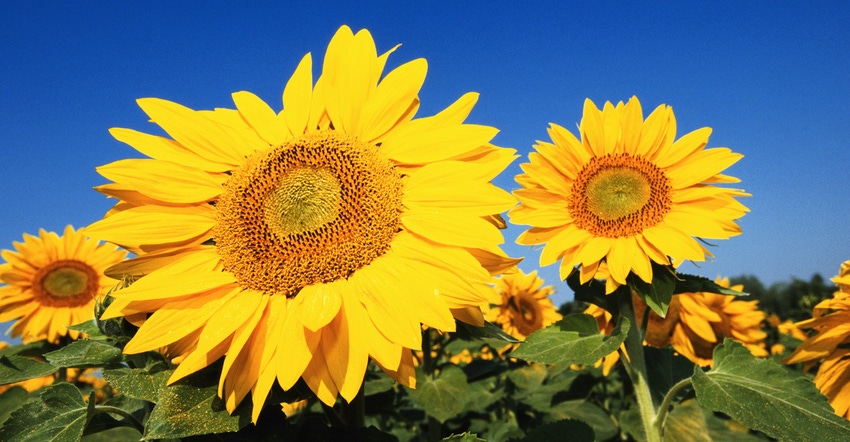
Sunflowers are big business in North Dakota and South Dakota, with North Dakota growers topping the nation with 1.34 billion pounds of production last year, and South Dakota next at 1.17 billion pounds.
With that level of production and impact on the states’ agricultural landscape, it’s critical to maintain healthy crops. Febina Mathew, a South Dakota State University associate professor and field crops pathologist, says farmers need to concern themselves with five main sunflower diseases:
1. Phomopsis stem canker. Mathew says phomopsis stem canker has been present in the United States since the mid-1980s, and “it was kind of historically dismissed because the prevalence was low. People didn’t see the disease doing anything to compromise yield. But suddenly 2010 was a disease epidemic, and it did crush the production in the Dakotas and Minnesota.”
Phomopsis stem canker shows up on the sunflower plant in the R1 growth stage, starting with necrosis on the leaves. Over time it reaches the petiole, eventually forming a canker-looking lesion on the stem.
Mathew says seeing such symptoms don’t automatically point to the presence of phomopsis stem canker, as there are several other diseases that mimic those symptoms. She says phomopsis stem canker is triggered by rainfall or humidity of 90% or greater, causing the plants to wilt and lodge, which reduces yields by up to 40%.
According to Mathews, these foliar fungicide chemistries are labeled to manage sunflower fungal diseases:
Fungicide Resistance Action Committee 11 (strobilurin/Qol)
FRAC 7 (Succinate dehydrogenase inhibitor)
FRAC 3 (triazole/DMI)
In addition to applying fungicides to diseased crops, hybrid selection is important. “Most of the commercial hybrids that we have available in the market have partial resistance, meaning they don’t have complete resistance to the causal fungi, but they can tolerate the disease to certain level that you will still benefit,” Mathew says. Crop rotation with a non-host crop, such as wheat could definitely bring down the inoculum, so that’s recommended for producers.
2. Sunflower rust. As with phomopsis stem canker, other sunflower diseases can appear as rust, but Mathew says a telltale sign is brown dots on the leaf underside “that kind of resemble cinnamon specks. And if you move your thumb across and kind of spread those dots, it just basically smears, and that’s a sign that you have rust.”
Scouting fields is important, as Mathew says fungicide spraying is timed once the rust severity reaches 1% on the upper four leaves of the plant. “When the crop is at R5 and the disease severity is about 1% on the upper leaves, that would be the time to spray against rust.” Qols and triazoles are effective against rust, and she adds that rust-resistant hybrids are also available.
3. White mold or sclerotinia diseases. Mathew points out that sunflower diseases are often dictated by the growing environment, as some are more prevalent in the hot and dry regions of the southern U. S., while others are more prone in the wetter and cooler regions of the Upper Midwest. There’s even variance between South Dakota and North Dakota as sclerotinia diseases or white mold are more of a problem in North Dakota.
“Diseases caused by Sclerotinia sclerotiorum are favored by wet and cool conditions,” she says. The causal fungus is known to infect soybeans and other broadleaf crops and weeds. In sunflowers, this fungus causes three different diseases on sunflowers:
wilt or basal stalk rot
middle stem rot
head rot
Mathew says this disease does not discriminate, impacting most crops grown in the region except for corn and wheat.
Management of sclerotinia disease can be difficult, as fungicides have little to no effect, and Mathew says genetic work continues to improve on the hybrids available that show a level of resistance. With that, she suggests crop rotation, including corn and wheat.
4. Downy mildew. This is a disease of seedlings that is not caused by a fungus, but rather a fungus-like organism that craves wet soil. Infected plants will have stunted growth with discoloration of leaves showing white to gray patches underneath.
Mathew says secondary infection do not cause yield loss, but if conditions are right for promoting the disease growth, producers can see reduced stands and yield loss.
As far as management, she says planting hybrids with resistance to the downy mildew organism is important. However, because new races of the organism can develop, resistance alone may not be sufficient. Fungicide seed treatments such as those containing oxathiopiprolin and azoxystrobin appear to be effective against downy mildew.
5. Phoma black stem. This common disease prefers frequent rainstorms, and Mathew says symptoms can resemble those of phomopsis stem canker. As the name implies, the lesions are black and superficial on the stem, versus the tan lesions of phomopsis. Though studies show yield losses back a few decades of up to 60% in South Dakota, today’s losses appear to be negligible.
As for management, Mathew stresses the importance of field scouting, paying attention to particular growth stages of the sunflower, to determine what diseases are present, adding that more than one of the diseases may be present simultaneously. He says research has found that fungicides have proven effective for both disease control and yield impact with a single application at R1 or multiple applications at V8 and R1.
It is also important to observe weeds near commercial fields for disease symptoms, like wild sunflowers, which can have lesions of phomopsis or phoma, or carry rust.
Read more about:
SunflowersAbout the Author(s)
You May Also Like






